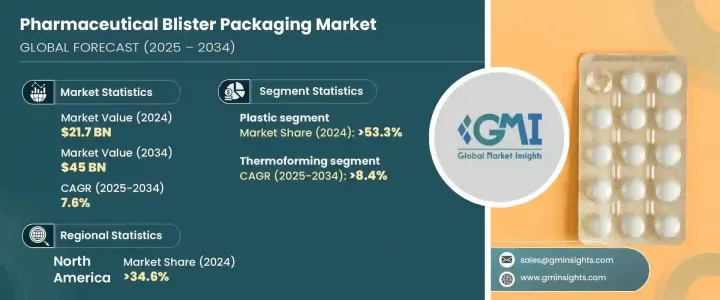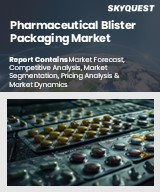
|
시장보고서
상품코드
1684574
의약품 블리스터 포장 시장 : 기회, 성장 촉진요인, 산업 동향 분석(2025-2034년)Pharmaceutical Blister Packaging Market Opportunity, Growth Drivers, Industry Trend Analysis, and Forecast 2025 - 2034 |
||||||
세계의 의약품 블리스터 포장 시장은 2024년에 217억 달러로 평가되었으며, 2025년부터 2034년에 걸쳐 CAGR 7.6%로 성장할 것으로 예측됩니다.
이러한 성장은 전 세계적으로 의약품 제품을 위한 안전하고 효율적이며 보호적인 포장 솔루션에 대한 수요가 급증하고 있음을 반영합니다. 의약품 블리스터 포장은 향상된 제품 보호, 유통 기한 연장 및 향상된 약물 순응도를 제공하는 능력으로 인해 제조업체와 의료 서비스 제공 업체 사이에서 선호되는 선택으로 부상했습니다.

포장 재료 및 기술의 발전과 지속 가능한 솔루션에 대한 강조가 증가하면서 시장 성장에 더욱 박차를 가하고 있습니다. 또한 의약품 산업의 성장, 만성 질환 유병률 증가, 엄격한 규제 표준을 준수하는 포장 솔루션에 대한 필요성이 수요를 주도하고 있습니다. 또한 내용물의 명확한 가시성, 변조 방지 기능 등 블리스터 포장이 제공하는 편리함과 사용 용이성은 현대 의약품 포장의 필수 솔루션으로 입지를 굳히고 있습니다.
| 시장 범위 | |
|---|---|
| 시작 연도 | 2024년 |
| 예측 연도 | 2025-2034년 |
| 시작 금액 | 217억 달러 |
| 예측 금액 | 450억 달러 |
| CAGR | 7.6% |
재료별로 보면, 시장은 플라스틱, 알루미늄 호일, 종이로 분류되며, 플라스틱 부문이 2024년 시장 점유율의 53.3%를 차지하며 선두를 달리고 있습니다. PVC, PET, 폴리카보네이트와 같은 플라스틱은 다용도로 사용할 수 있고 비용 효율적이기 때문에 민감한 의약품 제품을 습기, 빛, 오염으로부터 보호하는 데 이상적인 선택으로 널리 사용되고 있습니다. 또한 이러한 소재는 우수한 차단 특성을 제공하며 제조업체가 다양한 모양과 크기의 블리스터 팩을 디자인할 수 있어 의약품 회사의 다양한 요구 사항을 충족할 수 있습니다. 플라스틱의 유연성과 내구성 덕분에 제조업체는 안전 및 품질 표준을 준수하면서 디자인을 혁신할 수 있습니다.
또한 시장은 콜드 폼 성형, 열 성형, 열 밀봉 등 기술별로 세분화되어 있습니다. 특히 열 성형은 상당한 주목을 받고 있으며 연평균 8.4%의 높은 성장률로 2034년까지 245억 달러에 달할 것으로 예상됩니다. 이 기술은 고품질의 비용 효율적인 블리스터 팩을 대규모로 생산할 수 있다는 점에서 돋보입니다. 열성형 기술은 플라스틱 시트를 유연한 상태로 가열하여 정확한 캐비티 치수로 성형함으로써 정제, 캡슐 및 기타 의약품을 안전하게 보관하여 보관 및 운송 중 손상이나 오염의 위험을 최소화합니다.
2024년 북미는 의약품 블리스터 포장 시장의 34.6%를 차지했으며, 특히 미국이 괄목할 만한 성장세를 보이고 있습니다. 환자 중심의 헬스케어 포장 수요가 증가하고 지속 가능한 솔루션에 대한 관심이 높아지면서 이 지역의 혁신에 박차를 가하고 있습니다. 제조업체들은 환경 문제를 해결하기 위해 생분해성 플라스틱과 종이 기반 대체재와 같은 재활용 가능한 소재를 도입하고 있습니다. 또한 변조 방지 기능과 향상된 사용성으로 포장 디자인을 개선하여 복약 순응도를 높이고 환자의 안전을 보장함으로써 이 지역의 시장 지배력을 더욱 공고히 하고 있습니다.
목차
제1장 조사 방법과 조사 범위
- 시장 범위와 정의
- 기본 추정과 계산
- 예측 계산
- 데이터 소스
- 1차
- 2차
- 유료
- 공적
제2장 주요 요약
제3장 업계 인사이트
- 업계 생태계 분석
- 밸류체인에 영향을 주는 요인
- 변혁
- 장래 전망
- 제조업체
- 유통업체
- 이익률 분석
- 주요 뉴스와 대처
- 규제 상황
- 영향요인
- 성장 촉진요인
- 지속 가능하고 규정을 준수하는 블리스터 포장 솔루션 도입
- 의약품 소비를 주도하는 만성 질환의 유병률 증가
- 제네릭 의약품 제조 확대
- 약물 보호 강화를위한 콜드 폼 호일 기술의 발전
- 전자 약국의 성장과 변조 방지 포장 솔루션에 대한 수요
- 업계의 잠재적 리스크 및 과제
- 다양한 약물 제형에 대한 블리스터 포장 맞춤화의 복잡성
- 경기 침체가 의약품 포장 투자에 미치는 영향
- 성장 촉진요인
- 성장 가능성 분석
- Porter's Five Forces 분석
- PESTEL 분석
제4장 경쟁 구도
- 소개
- 기업의 시장 점유율 분석
- 경쟁 포지셔닝 매트릭스
- 전략 전망 매트릭스
제5장 시장 추계 및 예측 : 재료별(2021-2034년)
- 주요 동향
- 플라스틱
- 알루미늄 호일
- 종이
제6장 시장 추계 및 예측 : 기술별(2021-2034년)
- 주요 동향
- 콜드 폼 성형
- 열 성형
- 열 밀봉
제7장 시장 추계 및 예측 : 최종 용도별(2021-2034년)
- 주요 동향
- 정제 및 캡슐
- 의료 기기
- 주사제
- 기타
제8장 시장 추계 및 예측 : 지역별(2021-2034년)
- 주요 동향
- 북미
- 미국
- 캐나다
- 유럽
- 영국
- 독일
- 프랑스
- 이탈리아
- 스페인
- 러시아
- 아시아태평양
- 중국
- 인도
- 일본
- 한국
- 호주
- 라틴아메리카
- 브라질
- 멕시코
- 중동 및 아프리카
- 남아프리카
- 사우디아라비아
- 아랍에미리트(UAE)
제9장 기업 프로파일
- ACG
- Amcor
- Aptar
- Borealis
- Caprihans
- Carcano
- Constantia
- Dow
- Honeywell
- Huhtamaki
- Renolit
- Rohrer
- Romaco
- Sonoco
- Sudpack
- Syensqo
- Tekni-Plex
- Tjoapack
- VinylPlus
- WestRock
- Winpak
The Global Pharmaceutical Blister Packaging Market was valued at USD 21.7 billion in 2024 and is projected to grow at an impressive CAGR of 7.6% between 2025 and 2034. This growth reflects a surging demand for secure, efficient, and protective packaging solutions for pharmaceutical products worldwide. Pharmaceutical blister packaging has emerged as a preferred choice among manufacturers and healthcare providers due to its ability to offer enhanced product protection, extended shelf life, and improved medication adherence.

Rising advancements in packaging materials and technologies, coupled with an increasing emphasis on sustainable solutions, are further fueling market growth. The demand is also driven by the growing pharmaceutical industry, rising prevalence of chronic diseases, and a need for packaging solutions that comply with stringent regulatory standards. Moreover, the convenience and ease of use offered by blister packaging, such as clear visibility of contents and tamper-evident features, continue to solidify its position as an essential solution for modern pharmaceutical packaging.
| Market Scope | |
|---|---|
| Start Year | 2024 |
| Forecast Year | 2025-2034 |
| Start Value | $21.7 Billion |
| Forecast Value | $45 Billion |
| CAGR | 7.6% |
In terms of material, the market is categorized into plastic, aluminum foil, and paper, with the plastic segment leading, holding 53.3% of the market share in 2024. Plastics such as PVC, PET, and polycarbonate are widely used due to their versatile and cost-effective nature, making them an ideal choice for protecting sensitive pharmaceutical products from moisture, light, and contamination. These materials also offer excellent barrier properties and enable manufacturers to design blister packs in a wide array of shapes and sizes, meeting the diverse needs of pharmaceutical companies. The flexibility and durability of plastics allow manufacturers to innovate in design while ensuring adherence to safety and quality standards.
The market is also segmented by technology, including cold forming, thermoforming, and heat sealing. Thermoforming, in particular, is gaining significant traction and is projected to grow at a robust CAGR of 8.4%, reaching USD 24.5 billion by 2034. This technology stands out for its ability to produce high-quality and cost-efficient blister packs on a large scale. By heating plastic sheets into a pliable state and molding them into precise cavity dimensions, thermoforming ensures that tablets, capsules, and other pharmaceutical products are securely housed, minimizing the risk of damage or contamination during storage and transport.
In 2024, North America accounted for 34.6% of the pharmaceutical blister packaging market, with the United States experiencing remarkable growth. The increasing demand for patient-centric healthcare packaging and the rising focus on sustainable solutions have spurred innovation in the region. Manufacturers are introducing recyclable materials like biodegradable plastics and paper-based alternatives to address environmental concerns. Additionally, packaging designs are being enhanced with tamper-evident features and improved usability, supporting better medication adherence and ensuring patient safety, further solidifying the region's dominance in the market.
Table of Contents
Chapter 1 Methodology & Scope
- 1.1 Market scope & definitions
- 1.2 Base estimates & calculations
- 1.3 Forecast calculations
- 1.4 Data sources
- 1.4.1 Primary
- 1.4.2 Secondary
- 1.4.2.1 Paid sources
- 1.4.2.2 Public sources
Chapter 2 Executive Summary
- 2.1 Industry synopsis, 2021-2034
Chapter 3 Industry Insights
- 3.1 Industry ecosystem analysis
- 3.1.1 Factor affecting the value chain
- 3.1.2 Disruptions
- 3.1.3 Future outlook
- 3.1.4 Manufacturers
- 3.1.5 Distributors
- 3.2 Profit margin analysis
- 3.3 Key news & initiatives
- 3.4 Regulatory landscape
- 3.5 Impact forces
- 3.5.1 Growth drivers
- 3.5.1.1 Introduction of sustainable and regulatory-compliant blister packaging solutions
- 3.5.1.2 Growing prevalence of chronic diseases driving pharmaceutical consumption
- 3.5.1.3 Expansion of generic drug manufacturing
- 3.5.1.4 Advancements in cold form foil technology for enhanced drug protection
- 3.5.1.5 Growth in e-pharmacies and demand for tamper-evident packaging solutions
- 3.5.2 Industry pitfalls & challenges
- 3.5.2.1 Complexities in customization of blister packaging for diverse drug formulations
- 3.5.2.2 Impact of economic slowdowns on pharmaceutical packaging investments
- 3.5.1 Growth drivers
- 3.6 Growth potential analysis
- 3.7 Porter's analysis
- 3.8 PESTEL analysis
Chapter 4 Competitive Landscape, 2024
- 4.1 Introduction
- 4.2 Company market share analysis
- 4.3 Competitive positioning matrix
- 4.4 Strategic outlook matrix
Chapter 5 Market Estimates & Forecast, By Material, 2021-2034 (USD Billion & Kilo Tons)
- 5.1 Key trends
- 5.2 Plastic
- 5.3 Aluminum foil
- 5.4 Paper
Chapter 6 Market Estimates & Forecast, By Technology, 2021-2034 (USD Billion & Kilo Tons)
- 6.1 Key trends
- 6.2 Cold forming
- 6.3 Thermoforming
- 6.4 Heat seal
Chapter 7 Market Estimates & Forecast, By End Use, 2021-2034 (USD Billion & Kilo Tons)
- 7.1 Key trends
- 7.2 Tablets & capsules
- 7.3 Medical devices
- 7.4 Injectables
- 7.5 Others
Chapter 8 Market Estimates & Forecast, By Region, 2021-2034 (USD Billion & Kilo Tons)
- 8.1 Key trends
- 8.2 North America
- 8.2.1 U.S.
- 8.2.2 Canada
- 8.3 Europe
- 8.3.1 UK
- 8.3.2 Germany
- 8.3.3 France
- 8.3.4 Italy
- 8.3.5 Spain
- 8.3.6 Russia
- 8.4 Asia Pacific
- 8.4.1 China
- 8.4.2 India
- 8.4.3 Japan
- 8.4.4 South Korea
- 8.4.5 Australia
- 8.5 Latin America
- 8.5.1 Brazil
- 8.5.2 Mexico
- 8.6 MEA
- 8.6.1 South Africa
- 8.6.2 Saudi Arabia
- 8.6.3 UAE
Chapter 9 Company Profiles
- 9.1 ACG
- 9.2 Amcor
- 9.3 Aptar
- 9.4 Borealis
- 9.5 Caprihans
- 9.6 Carcano
- 9.7 Constantia
- 9.8 Dow
- 9.9 Honeywell
- 9.10 Huhtamaki
- 9.11 Renolit
- 9.12 Rohrer
- 9.13 Romaco
- 9.14 Sonoco
- 9.15 Sudpack
- 9.16 Syensqo
- 9.17 Tekni-Plex
- 9.18 Tjoapack
- 9.19 VinylPlus
- 9.20 WestRock
- 9.21 Winpak


















